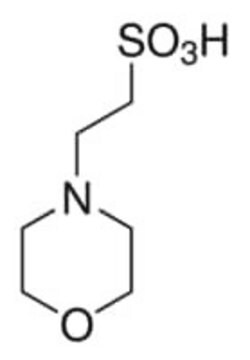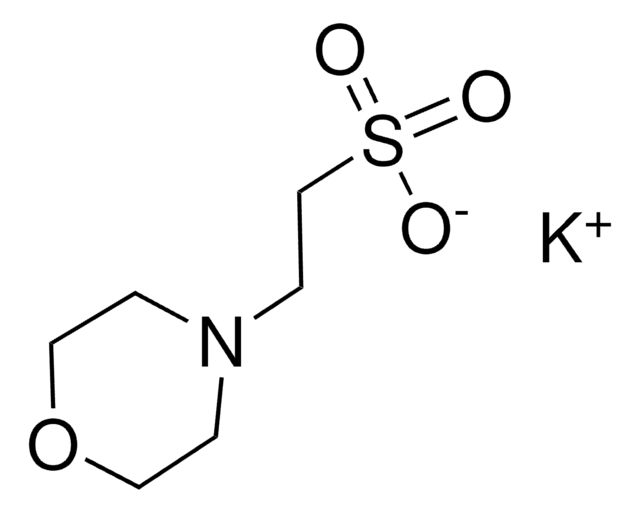Key Documents
M3058
MES sodium salt
BioPerformance Certified, suitable for cell culture
Synonim(y):
4-Morpholineethanesulfonic acid, sodium salt, Sodium 2-Morpholinoethanesulfonate, 2-(N-Morpholino)ethanesulfonic acid sodium salt, 4-Morpholineethanesulfonic acid sodium salt
About This Item
Polecane produkty
Poziom jakości
klasa czystości
BioPerformance Certified
for molecular biology
Postać
crystalline powder
warunki przechowywania
dry at room temperature
metody
cell culture | mammalian: suitable
zanieczyszczenia
endotoxin and total aerobic microbial count, tested
kolor
white
przydatny zakres pH
5.5-6.7
pKa
6.1
rozpuszczalność
water: 335.3 g/L at 20 °C
przydatność
suitable for component for culture media
suitable for molecular biology
Zastosowanie
agriculture
diagnostic assay manufacturing
life science and biopharma
sample preparation
obecność zanieczyszczeń
DNase, NICKase, RNase, protease, none detected
ciąg SMILES
[Na+].[O-]S(=O)(=O)CCN1CCOCC1
InChI
1S/C6H13NO4S.Na/c8-12(9,10)6-3-7-1-4-11-5-2-7;/h1-6H2,(H,8,9,10);/q;+1/p-1
Klucz InChI
IRHWMYKYLWNHTL-UHFFFAOYSA-M
Szukasz podobnych produktów? Odwiedź Przewodnik dotyczący porównywania produktów
Opis ogólny
Zastosowanie
Cechy i korzyści
- Suitable for Molecular Biology and Cell Culture
- Tested for Endotoxins and Total Aerobic Microbial Count
- Free from DNase, NICKase, RNase, and Protease
- Effective Buffering from pH 5.5-6.7 (25 °C) with a pKa of 6.1 (25 °C)
Uwaga dotycząca przygotowania
Inne uwagi
produkt podobny
Kod klasy składowania
11 - Combustible Solids
Klasa zagrożenia wodnego (WGK)
WGK 1
Temperatura zapłonu (°F)
Not applicable
Temperatura zapłonu (°C)
Not applicable
Środki ochrony indywidualnej
Eyeshields, Gloves, type N95 (US)
Certyfikaty analizy (CoA)
Poszukaj Certyfikaty analizy (CoA), wpisując numer partii/serii produktów. Numery serii i partii można znaleźć na etykiecie produktu po słowach „seria” lub „partia”.
Masz już ten produkt?
Dokumenty związane z niedawno zakupionymi produktami zostały zamieszczone w Bibliotece dokumentów.
Klienci oglądali również te produkty
Nasz zespół naukowców ma doświadczenie we wszystkich obszarach badań, w tym w naukach przyrodniczych, materiałoznawstwie, syntezie chemicznej, chromatografii, analityce i wielu innych dziedzinach.
Skontaktuj się z zespołem ds. pomocy technicznej






